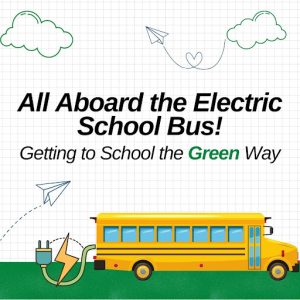All Aboard the Electric School Bus: Getting to School the Green Way
By Zyara Morton, C2ST Intern, University of Illinois Urbana-Champaign
Many feelings of nostalgia can arise when one thinks about their time in elementary through high school. For me, one of the most crucial aspects was going to the end of my street at 6:15 AM on the dot every morning for that familiar, bright yellow bus. School buses have been an integral part of U.S. school systems for decades, providing millions of children with reliable transportation every day. However, between the global climate crisis and public health concerns, individuals are becoming more interested in how transportation can be made more sustainable. School buses are at the forefront of this conversation, and there is a new method to help students get to school the green way: going electric.

The idea of ‘going electric’ has soared in public recognition in the past few years, especially due to the increased awareness of how diesel and gas based transportation interact with the environment. In the U.S., the majority of the over 400,000 school buses used by districts run on diesel. These vehicles negatively impact the environment by creating ground level ozone pollution, which damages crops and vegetation. Another product of these engines is acid rain which infects soil and water. Prolonged exposure to these pollutants can cause health deficits in humans, ranging from respiratory illnesses to the worsening of pre-existing heart and lung ailments. Electric school buses, on the other hand, can limit health complications, primarily through how they operate.
In comparison to diesel buses, electric buses use an electric motor that is battery-powered. These batteries recharge like a smartphone, and one charge can last for several hours. Therefore, these buses do not emit any gas or exhaust through pipes. Through a study done at the Harvard T.H. Chan School of Public Health, it was found that in comparison to older, diesel buses, electric buses emitted 181 fewer metric tons of carbon dioxide–a gas that is known to rapidly increase global temperatures. It was also estimated that the replacement of one diesel bus with an electric one could result in over 200,000 dollars worth of health benefits per bus. These estimates are incredibly significant, especially in metropolitan areas, where individuals suffer the most from pollution and its health consequences.
While electric buses are key components of future sustainable transportation, it is worth noting that switching completely from diesel to electric is not easy. From charging stations to specialized parts, researchers have estimated that an unsubsidized electric bus costs around 150,000 dollars more than its diesel counterpart. These concerns surrounding costs are valid, and lawmakers seem to be responding by putting in efforts to mitigate expenses. In 2021, the Biden administration passed a bipartisan infrastructure law that allocated five billion dollars towards electric school buses. These funds have already been making waves across state school districts, and according to Megha Lakhchaura, the Illinois state electric vehicle officer, Illinois has received around 90.7 million dollars for 372 electric buses in 2024 alone.
Electric buses are revolutionizing the way children get to and from school. They cut down on carbon emissions, and ensure the health and safety of thousands of people. Although a full switch is costly, with the support of lawmakers, and the start of transitioning to electric buses, we are already seeing a difference. And do not worry; these buses are changing in how they operate, but that same iconic yellow design remains.
References
- Slowly but Surely, U.S. School Buses are Starting to Electrify
- Learn About Impacts of Diesel Exhaust, and the Diesel Emissions Reduction Act (DERA)
- Electric Buses Guide: What They Are and How They Work
- Electric school buses may yield significant health and climate benefits, cost savings
- Climate Change: Atmospheric Carbon Dioxide
- Adopting electric school buses in the United States: Health and climate benefits
- The Future Looks Bright for Electric School Buses
- Bipartisan Infrastructure Law (BIL)/Infrastructure Investment and Jobs Act (IIJA)
- More school districts turn to electric school buses to transport students using federal rebates